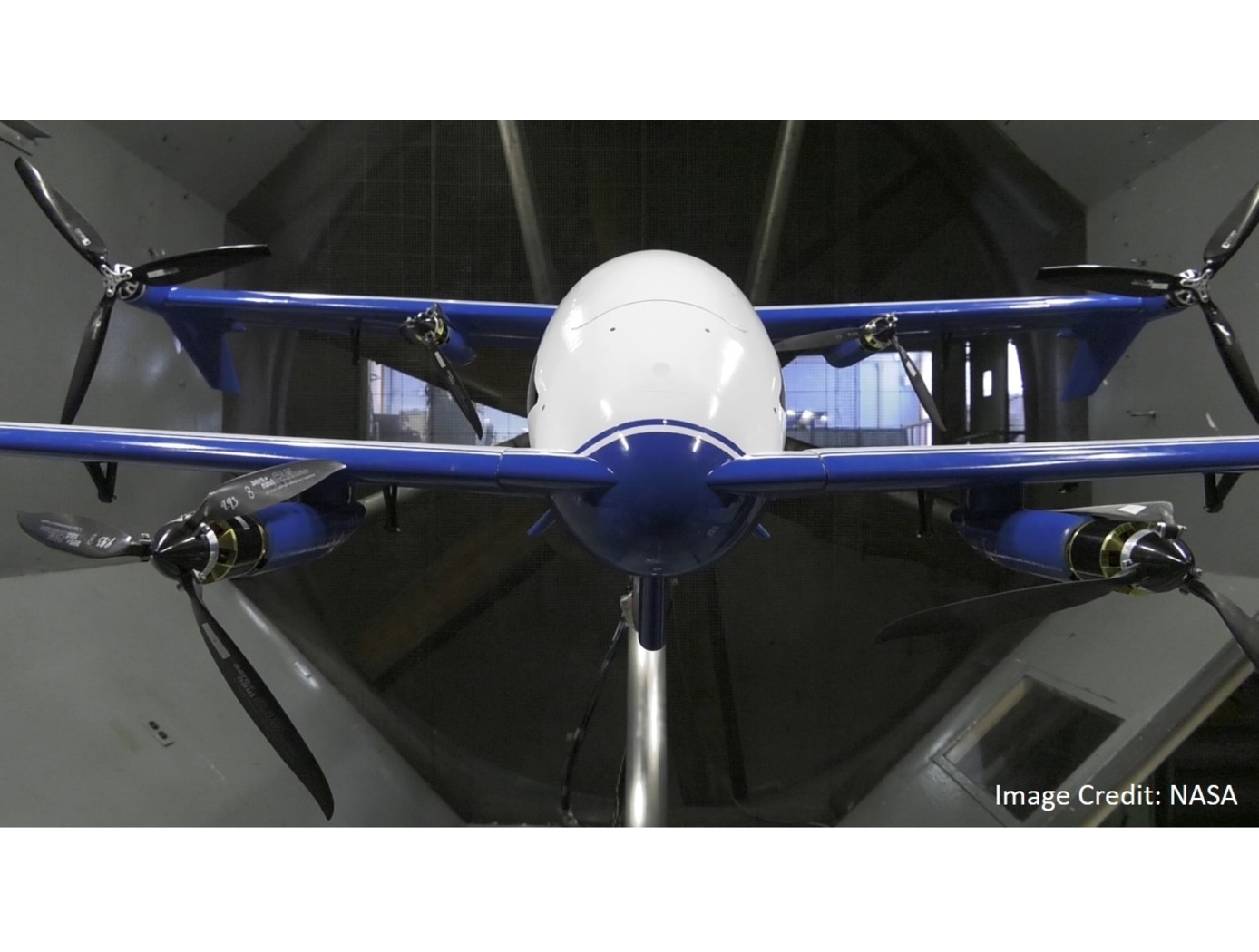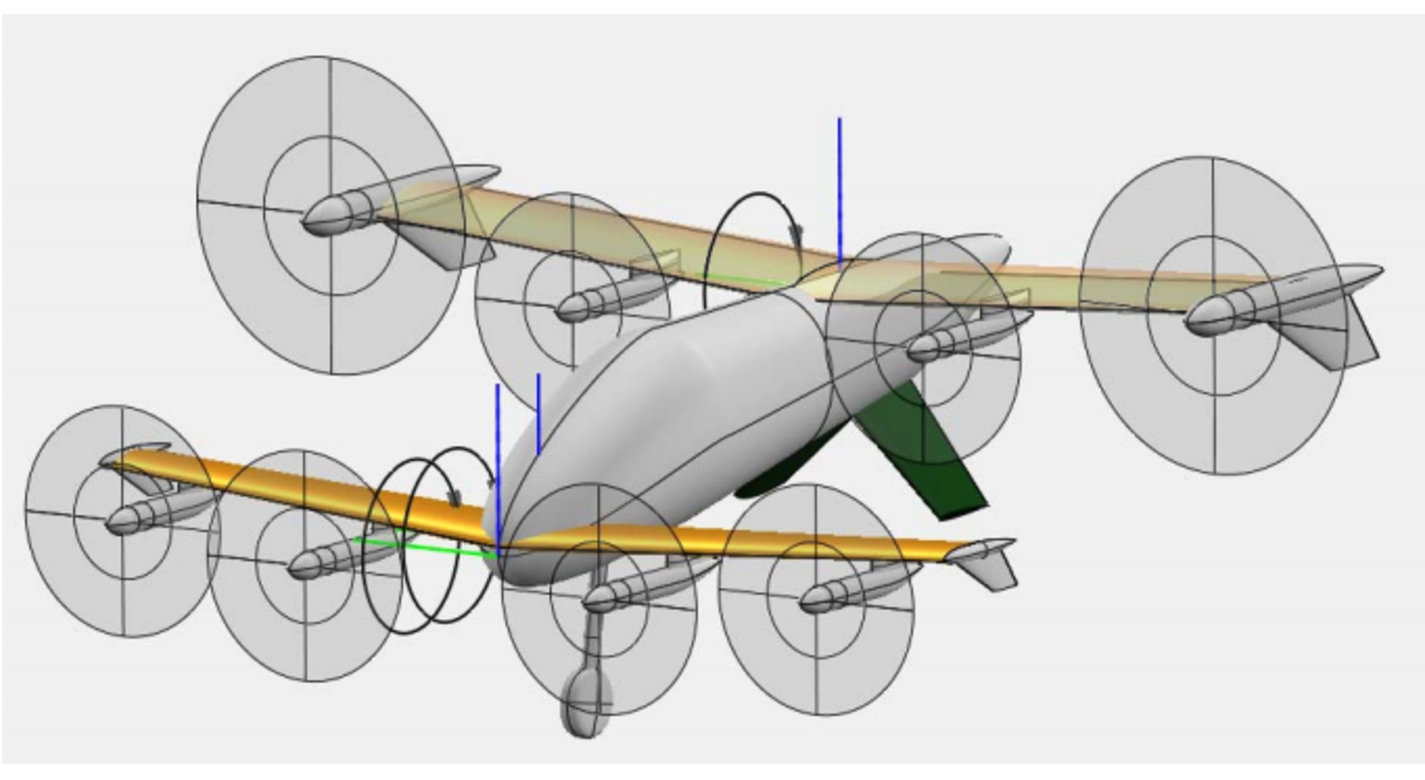Fixed Wing Angle eVTOL
Aerospace
Fixed Wing Angle eVTOL (LAR-TOPS-338)
VTOL Without Performance Limitations
Overview
Current electric vertical takeoff and landing aircraft (eVTOL) configurations for Urban Air Mobility (UAM) applications often require performance-hindering equipment only used for a specific operation (e.g., takeoff or cruising). The need for such equipment, such as separate lift and thrust mechanisms, often stems from the challenge posed by transitioning from hovering to forward flight. For example, tilt-wing eVTOLs have complex transition periods that can result in large pitching movements or wing stalling without adequate propulsion, potentially causing catastrophic loss of control. Increased equipment requirements for eVTOLs also increase system mass, negatively impacting performance.
Innovators at NASA's Langley Research Center recognized this issue and have developed a novel eVTOL solution design. The technology is a distributed electric propulsion, modular wing aircraft capable of vertical takeoff and landing, without requiring near 90° wing tilt. Instead, NASA's eVTOL uses large flaps and a fixed slight wing tilt to generate upward force, enabling VTOL operations, benign transition from hovering to forward flight, and increased safety and simplicity of operations.
The Technology
While previous eVTOLs often require a near 90° wing tilt to position propellers in an optimal location to generate vertical force for takeoff, NASA has taken a very different approach. NASA's design instead uses a slight wing angle and large flaps designed to deflect slipstream generated by the propellers to create a net positive force in the vertical direction, all while preventing forward movement. This unique configuration allows for takeoff and landing operations without the need for near 90° wing tilt angles. After takeoff, the transition to forward flight only requires a slight change in attitude of the vehicle and retraction of the flaps. Similar solutions require large changes in attitude to accomplish this transition which is often undesirable, especially for air taxi operations that involve passengers.
Given the effectiveness of this configuration for generating upward force, the requirement for wing angle tilt has been reduced from near 90° to approximately 15° during takeoff. Further iterations may reduce this requirement even further to 0°. By eliminating the need for near 90° wing tilt, NASA's eVTOL design removes the need for mechanisms to perform active tilting of the wings or rotors, reducing system mass and thereby improving performance. Flaps represent the only components that require actuation for takeoff and landing operations.
Innovators at NASA leveraged the Langley Aerodrome 8 (LA-8), a modular testbed vehicle that allows for rapid prototyping and testing of eVTOLs with various configurations, to design and test this novel concept.


Benefits
- Eliminated performance-hindering equipment: Removing the need for active wing angle actuation reduces hardware requirements, resulting in decreased mass and increased performance
- Smooth transition operations: Enables benign transition from hovering to forward flight (only requires a small attitude change) - ideal for air taxi applications
- Increased operational simplicity: Eliminates the need for mechanisms to manipulate wing angles during transitions from takeoff to forward flight
Applications
- Urban air mobility: eVTOL passenger vehicles for air taxi services
- Drone delivery: eVTOL delivery vehicles
- Industrial applications: eVTOL vehicles are being considered for use in various industries including agriculture and construction
Technology Details
Aerospace
LAR-TOPS-338
LAR-19644-1
LAR-18332-1
LAR-18332-1-CON
“An Experimental Approach to a Rapid Propulsion and Aeronautics Concept Testbed,” McSwain, Robert et. al., January 1, 2020,
https://ntrs.nasa.gov/citations/20200000698
https://ntrs.nasa.gov/citations/20200000698
Similar Results

Active Turbulence Suppression System for Electric Vertical Take-Off and Landing (eVTOL) vehicles
The Active Turbulence Suppression (ATS) system for electric Vertical Take-Off and Landing (eVTOL) vehicles employ existing lifting propellers to dampen instabilities during flight, such as Dutch-roll oscillations and other gust-induced oscillations. When a roll angle of an eVTOL aircraft has deviated or is about to deviate from a current stable aircraft state to an undesirable, unstable, and oscillating aircraft state, the ATS system queries a turbulence suppression database that stores a set of propeller speed profiles for mitigation a deviation of a given roll angle for a particular aircraft with specified propellers. Using this data, the eVTOL flight controller adjusts the speed of the propellers for a certain duration of time, according to the propeller speed profiles for mitigating the deviation. In models of aircraft with adjustable propeller angles, the database includes blade angle profiles for mitigating the effects of turbulent conditions. Timing and rate of propeller activation can be pre-computed using higher order computational modeling performed with NASA’s super computing resources. Because the data is pre-computed, the use of the ATS system onboard does not require significant computing resources to implement on eVTOL vehicles. The technology, a mechanism by which existing eVTOL propellers are leveraged to suppress gust-induced oscillations enables a safe and comfortable passenger experience at low-cost and without added hardware.

Rapid Aero Modeling for Computational Experiments
RAM-C interfaces with computational software to provide test logic and manage a unique process that implements three main bodies of theory: (a) aircraft system identification (SID), (b) design of experiment (DOE), and (c) CFD. SID defines any number of alternative estimation methods that can be used effectively under the RAM-C process (e.g., machine learning techniques, regression, neural nets, fuzzy modeling, etc.). DOE provides a statistically rigorous, sequential approach that defines the test points required for a given model complexity. Typical DOE test points are optimized to reduce either estimation error or prediction error. CFD provides a large range of fidelity for estimating aircraft aerodynamic responses. In initial implementations, NASA researchers “wrapped” RAM-C around OVERFLOW, a NASA-developed high-fidelity CFD flow solver. Alternative computational software requiring less time and computational resources could be also utilized.
RAM-C generates reduced-order aerodynamic models of aircraft. The software process begins with the user entering a desired level of fidelity and a test configuration defined in terms appropriate for the computational code in use. One can think of the computational code (e.g., high-fidelity CFD flow solver) as the “test facility” with which RAM-C communicates with to guide the modeling process. RAM-C logic determines where data needs to be collected, when the mathematical model structure needs to increase in order, and when the models satisfy the desired level of fidelity.
RAM-C is an efficient, statistically rigorous, automated testing process that only collects data required to identify models that achieve user-defined levels of fidelity – streamlining the modeling process and saving computational resources and time. At NASA, the same Rapid Aero Modeling (RAM) concept has also been applied to other “test facilities” (e.g., wind tunnel test facilities in lieu of CFD software).

Wind-Optimal Cruise Airspeed Mode for Flight Management Systems (FMS)
The novel approach for optimizing airspeed for both actual and predicted wind conditions in electric Vertical Takeoff and Landing (eVTOL) aircraft with Distributed Electric Propulsion (DEP) systems includes the process of creating a lookup table for wind‐optimal airspeed as a function of wind magnitude, considering the direction of the wind relative to the cruise segment, considering the cruise altitude for an aircraft type, and incorporating the wind-optimal airspeed lookup table in the performance database for real‐time access by the Flight Management Systems (FMS) to predict wind-optimal airspeed at waypoints of the flight plan. The target wind‐optimal airspeed is updated in real-time throughout the cruise portion of a flight.
In a test of the wind-optimal airspeed targeting technique using a multi-rotor aircraft model, results obtained show benefits of flying at the wind‐optimal cruise airspeed compared to the best‐range airspeed. In headwind conditions, energy consumption was reduced by up to 7.5%, and flight duration was reduced by up to 28%. Under uncertain wind magnitudes, flying at wind-optimal airspeed offered lower variability and higher predictability in energy consumption than flying at best‐range airspeed.

VTOL UAV With the Cruise Efficiency of a Conventional Fixed Wing UAV
The core technology that enables the Greased Lightning UAV is the aerodynamic efficiency it achieves in its cruise configuration. Electric motors at each propeller negate the need for drive shafts and gearing which enables this Distributed Electric Propulsion (DEP) aircraft configuration. The design is intended to utilize a hybrid electric drive system that includes small diesel engines which drive alternators to power the electric motors and to charge an on-board battery system. The batteries provide the power boost needed for VTOL and hovering. Numerous other novel design elements are incorporated, such as folding propellers to minimize drag when not in operation, such that the propulsive efficiency can be nearly ideal at both hover and wing borne flight conditions.

Aerodynamically Actuated Thrust Vectoring Device
The thrust actuating device includes several innovations in the aerodynamically stable tilt actuation of propellers, propeller pylons, jets, wings, and fuselages, collectively called propulsors. The propulsors rotate between hover and forward flight mode for a tilt-wing or tilt-rotor aircraft. A vehicle designed using this technology can transition from a hovering flight condition to a wing born flight condition with no mechanical actuation and can do so without complex control systems. This results in a reduction in system weight and complexity and produces a robust and naturally stable hovering aircraft with efficient forward flight modes.



